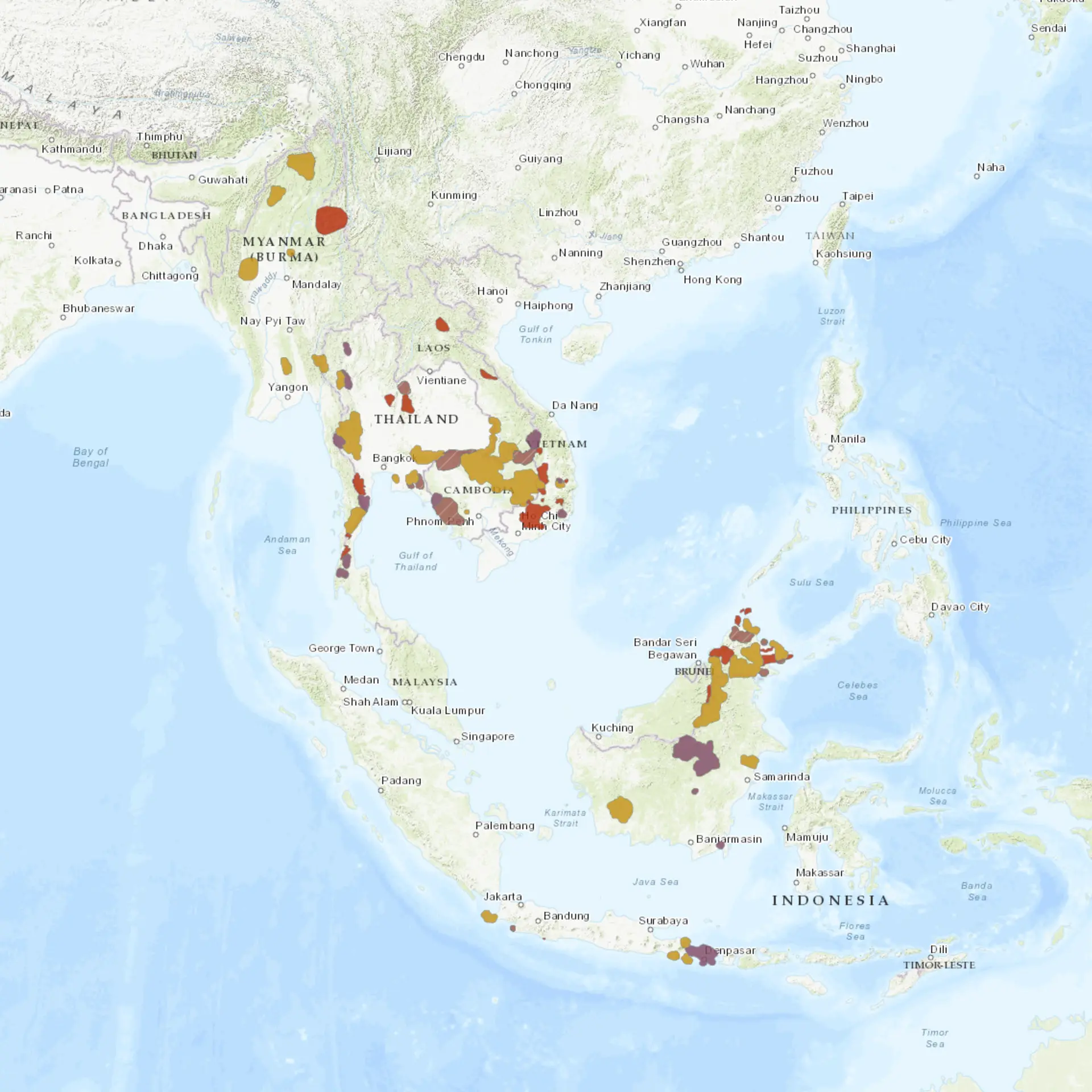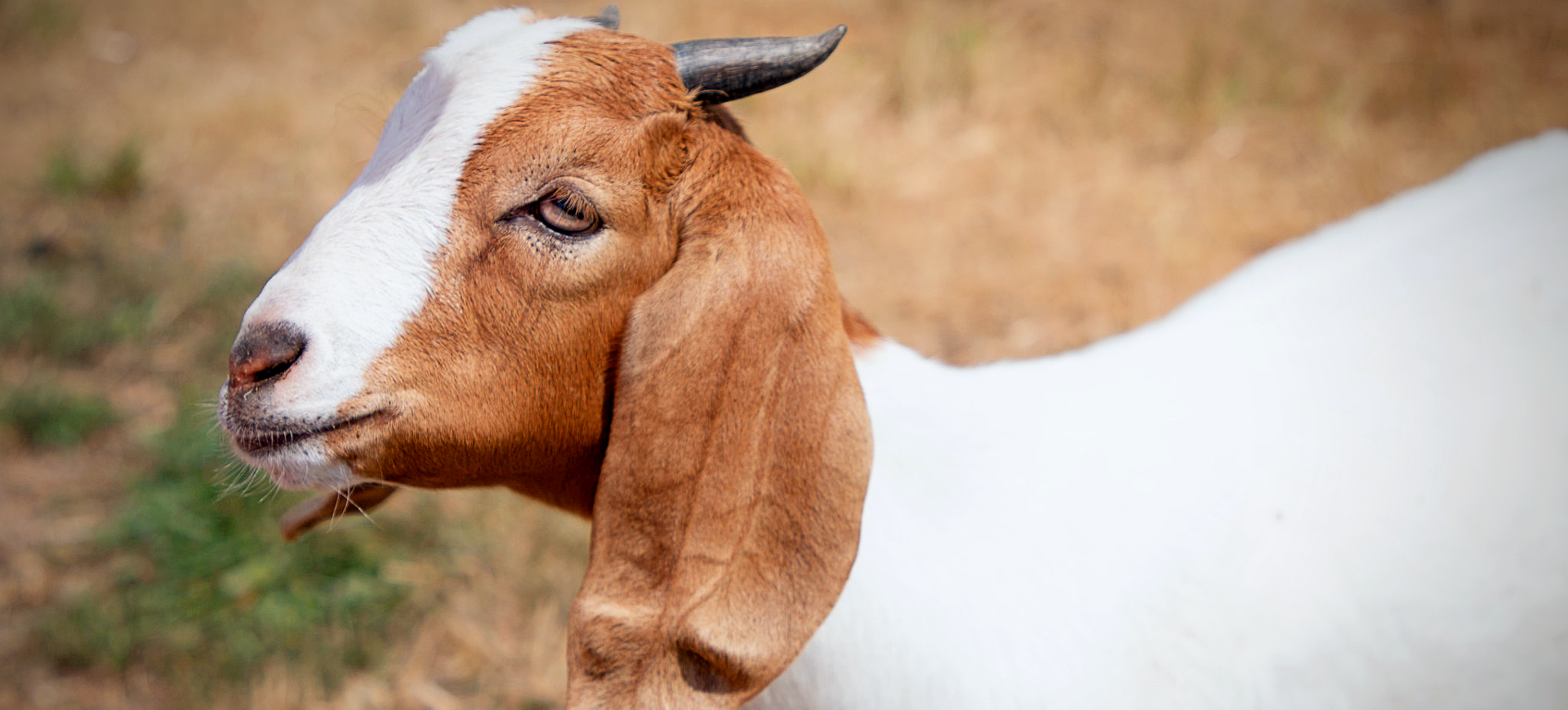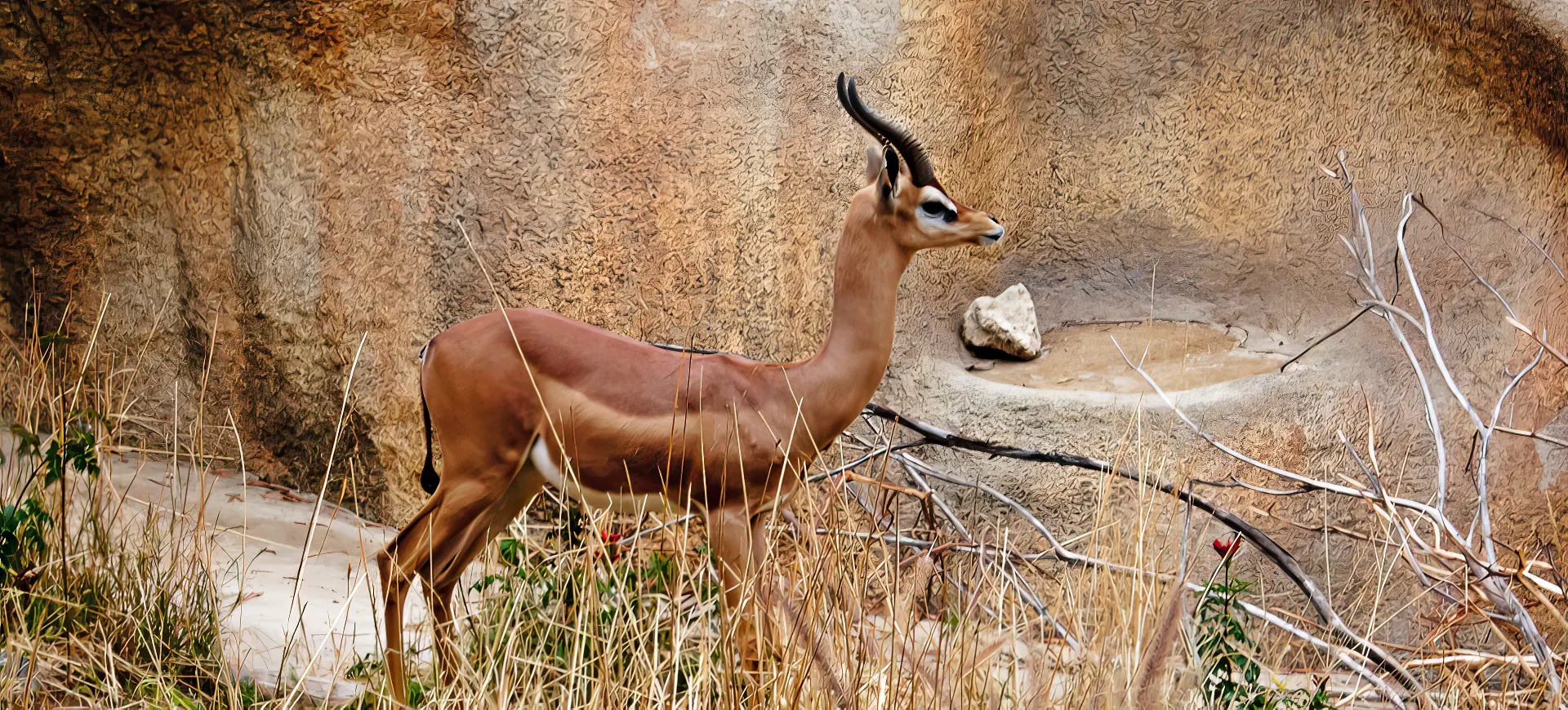Overview
The Banteng (Bos javanicus), also known as tembadau, is a species of wild cattle found in Southeast Asia. Bantengs are notable for their impressive physique, characterized by a muscular build, a slight hump at the shoulders, and upward-curving horns in both sexes, although males tend to have larger horns. Adult males exhibit a dark brown or black coat, while females and juveniles typically sport a chestnut color. This species is unique in its ability to thrive in forested and grassland habitats, demonstrating significant ecological flexibility.
Bantengs play a crucial role in their ecosystems by affecting vegetation patterns and providing prey for large predators such as tigers and leopards. They are generally shy and elusive, preferring dense forest cover or areas with sufficient vegetation to conceal their presence. Socially, bantengs are gregarious and can be found in small herds consisting mainly of females and juveniles, led by a single dominant male. The survival of the species is closely linked to the preservation of their natural habitats, which are increasingly threatened by human activities.
In culture and agriculture, bantengs have been semi-domesticated in several regions for centuries. These domesticated forms are used for their meat, milk, and as draught animals. However, wild populations are under significant pressure due to habitat loss, hunting, and hybridization with domestic cattle, leading to genetic pollution.
Taxonomy
Kingdom
Phylum
Class
Order
Family
Genus
Species
Type
Current distribution:
The wild populations of banteng are primarily found in protected reserves and national parks across Southeast Asia. Their range has significantly contracted compared to historical records, primarily due to habitat loss and poaching. In countries like Indonesia and Malaysia, isolated populations are increasingly threatened by the encroachment of agricultural lands and urban development.
Conservation areas and national parks play a critical role in the survival of the banteng, offering them a refuge from hunting and habitat destruction. Efforts to map and understand the distribution of bantengs are crucial for effective conservation strategies, as many populations are small and fragmented, making them vulnerable to extinction.
Physical Description:
Males typically display a darker coloration than females, ranging from a deep, dark brown to almost black, whereas females maintain a consistent light brown or chestnut throughout their lives. Both genders possess a distinctive dorsal ridge and long, upward-curving horns, which can reach impressive lengths, demonstrating their maturity and vigor. The body structure of the banteng is robust and muscular, adapted for survival in dense forests and rugged terrain, which also aids in evading predators.
Despite their bulk, bantengs are agile and quick, capable of swift movements through thick underbrush and forested areas. They are medium to large-sized cattle, with males generally larger and more muscular than females, showcasing significant sexual dimorphism. The physical traits of bantengs, including their hoofed feet and ruminating digestive system, are typical of bovid species, underscoring their adaptations for a grazing lifestyle.

Lifespan: Wild: ~20 Years || Captivity: ~26 Years

Weight: Male: 1,500-1,800 lbs (680-816 kg) || Female: 660-880 lbs (300-400 kg)

Length: Male: 66-86 in (168-219 cm) || Female: 60-75 in (152-191 cm)

Height: Male: 55-65 in (140-165 cm) || Female: 52-60 in (132-152 cm)

Top Speed: 30 mph (48 km/h)
Characteristic:
Native Habitat:
Bantengs are native to Southeast Asia’s dense forests and grasslands, including parts of Indonesia, Malaysia, Thailand, and Myanmar. They are adapted to various environments, from dry deciduous forests to secondary forests, which offer food and cover. Adapting to diverse habitats has historically helped the banteng survive, but their populations are now mostly restricted to protected areas.
The species’ preference for forest edges and secondary growth means they can often be found near agricultural areas, leading to human-wildlife conflicts. However, the proximity to human settlements has also facilitated the semi-domestication of some banteng populations, which are bred and raised for agricultural purposes.
Climate Zones:
Biomes:
Biogeographical Realms:
Continents:
Diet:
Diet & Feeding Habits:
Bantengs are herbivores, primarily grazing on a variety of grasses, but they also browse on leaves, fruits, and flowers. Their diet is flexible and can vary with the availability of resources in their habitat. This adaptability in feeding helps them survive in both forested and open grassland environments. They typically feed during the cooler parts of the day, such as early morning or late afternoon, to avoid the midday heat and potential predators.
In addition to natural foraging behaviors, bantengs visit salt licks, which are essential for providing minerals that are not always available in their regular diet. Their feeding habits contribute significantly to the dispersal of seeds and the maintenance of plant diversity within their habitats. The degradation of their habitats has impacted their diet, as areas with rich and diverse food sources are becoming increasingly scarce due to human activities.
Mating Behavior:
Mating Description:
Bantengs exhibit a polygynous mating system where dominant males control access to groups of females during the breeding season. Males often engage in displays of strength and prowess to assert dominance and attract mates, including vocalizations, horn wrestling, and other physical displays. The breeding season tends to be seasonal, aligning with the availability of food resources to ensure the maximum survival rate for the offspring.
The gestation period for bantengs is approximately nine months, after which a single calf is usually born. Calves are weaned at around six to nine months of age but may remain with their mothers longer. The reproductive success of bantengs is closely linked to their habitat’s quality, with better-nourished females in high-quality habitats experiencing higher reproductive rates.
Reproduction Season:
Birth Type:
Pregnancy Duration:
Female Name:
Male Name:
Baby Name:
Social Structure Description:
Bantengs are social animals. They are typically found in groups consisting of females and their young, with adult males either solitary or forming smaller bachelor groups. The social hierarchy within these groups is relatively fluid, with dominance based on size, strength, and age. This structure helps manage resources within their habitat and protects against predators.
During the mating season, the social structure becomes more pronounced, with dominant males actively defending their status to access breeding females. The cohesion of female groups plays a critical role in the rearing of calves, providing them with protection and learning opportunities through social interactions.
Groups:
Conservation Status:
Population Trend:
The global population of wild banteng is estimated to be fewer than 8,000 individuals, spread across several fragmented habitats in Southeast Asia. The species faces significant threats from habitat loss, hunting, and hybridization with domestic cattle, which complicates conservation efforts and threatens the genetic purity of wild populations. In some areas, banteng populations are stable due to stringent conservation measures, but the species is considered endangered overall.
Conservation strategies for the banteng include habitat preservation, anti-poaching efforts, and genetic studies to understand the extent of hybridization with domestic cattle. Efforts are also being made to enhance public awareness about the species and its plight, which is vital for garnering support for conservation initiatives. Protected areas and wildlife sanctuaries are critical for the banteng’s survival, providing a refuge from human pressures.
Population Threats:
The primary threats to Banteng include habitat destruction due to logging, agricultural expansion, and urban development. These activities not only reduce the living space available to Banteng but also fragment their populations, making genetic diversity and survival more challenging. Poaching for meat and horns continues to be a significant threat despite legal protections.
Hybridization with domestic cattle is another critical concern, as it dilutes the wild banteng gene pool, potentially reducing the species’ resilience to environmental changes and disease. The illegal wildlife trade also poses a risk to bantengs, with demand for their body parts used in traditional medicine and as trophies.
Conservation Efforts:
Conservation efforts for the banteng are focused on habitat protection, legal enforcement to prevent poaching, and the establishment of breeding programs in captivity to help bolster wild populations. Several international and local organizations are working together to implement these strategies, focusing on critical areas where banteng populations are known to exist. Education and community engagement are also part of these efforts, helping to reduce human-wildlife conflicts and promote coexistence.
Research into the genetics and behavior of banteng populations aids in managing and planning conservation strategies more effectively. Initiatives such as satellite tracking and population monitoring are vital for assessing the success of conservation measures and understanding the movements and needs of the species.
Additional Resources:
Fun Facts
- Bantengs can interbreed with domestic cattle, and their hybrids are often raised for agriculture.
- The species has two distinct color phases: wild-type and domestic-type, influenced by their environment and breeding.
- Bantengs are excellent swimmers, often crossing rivers and swamps in their natural habitats.
- They have a keen sense of smell and hearing, which helps them detect predators and communicate within the herd.
- Bantengs can rotate their ears independently to pick up sounds from different directions.
- The horns of a banteng can grow up to 75 cm in length.
- They are one of the few bovine species in which both males and females have horns.
- Bantengs contribute to their ecosystems by facilitating seed dispersal through their dung.
- They are depicted in ancient cave paintings in Indonesia, highlighting their long-standing significance to human cultures.
- Conservation programs for banteng include genetic studies to differentiate wild populations from those interbred with domestic cattle.

















































































